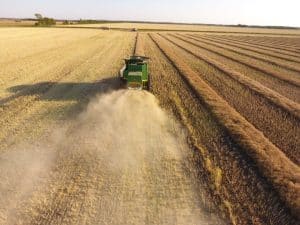Cut height and residue spreading can influence stand establishment next spring. For the latest version of this article, please read Manage residue with the combine alone.
Stubble height
Taller stubble height will trap more snow, increasing potential soil moisture next spring. Preserving moisture is more important in dry years, which is also when plant height tends to be shorter. This makes tall stubble a tall order, so “cut as high as possible” is about all we can say in this situation.
Phillip Harder, formerly with the Centre for Hydrology at the University of Saskatchewan and now research director and hydrological scientist with Croptimistic Technology, has researched snow trap and stubble. His work shows that, in dry conditions, snow trapped in stubble and available to infiltrate in the spring doubles when you increase stubble height from 10 cm (4”) to 20 cm (8”), for example. He says benefits increase up to about 30 cm (12″ ) stubble height.
Harder also says stubble “drastically reduces” sublimation of the snowpack in the middle of winter. Sublimation is the conversion of water from the snow (solid) to vapour phase bypassing the intermediate liquid stage. Harder describes two main mechanisms of sublimation on the Canadian Prairies. The first happens when solar radiation (sunlight) drives the phase change, then dry warm air absorbs the water vapour and wind blows it away. The second happens during blowing snow events where snow particles that get suspended in the windy and turbulent air mass are very efficiently sublimated into the airmass. Harder says sublimation is most intense in windy and open areas where chinooks are common and there are not a lot of obstructions to slow down the wind. It is less extreme in areas with more bush and without chinooks.

Combine adjustments to improve residue management
If the combine can provide a thin even layer of residue, this could eliminate the need for any further field operations to manage residue. Check spread patterns to see how performance can be improved. If displeased with the results, change one setting on the combine at a time to mark differences in performance. Here’s where to look to make changes:
- Vanes. Changing the angle of vanes on the back of the chopper can be a simple and effective step, having one of the biggest impacts on the width and uniformity of residue spread.
- Cut height. Cutting higher means less residue goes through the combine, which leaves less to spread over the soil surface. Ideally, find a cut height that is tall enough to improve residue spreader performance but not too tall as to affect residue flow through the drill in the spring – if that is an issue with the drill. One foot stubble height is a good target, but some farmers use stripper headers that leave basically all of the stubble standing.
- Spread width. Larger header widths are becoming popular, which can present a challenge to the spreader’s ability to reach that same width for even distribution. Combine specialists say it can be done, it just takes time and patience with the altering of settings. Varying environmental conditions will play a role in spread performance, so settings may need to be adjusted again to suit the changing conditions.
- Chopper knives. Make sure straw chopper knives/blades are sharp. Stationary knives are important, so make sure they are sharp as well. Adjust stationary knife height as needed to increase chopping. Check chopper knives regularly.
- Fan speed or chopper speed. Higher speeds may be necessary in heavy stubble or with wide headers. However, when it comes to fan speed the first consideration should be to limit harvest seed loss. Crop yield takes a priority over residue distribution in this case. A better option may be chopper speed increases.
- Chaff spreader. Adjust as needed to get chaff spread as wide and thin as possible. Spreading chaff equally is going to depend on the type of combine. Rotor and conventional combines are fed differently and the distribution of chaff and straw is going to come out differently between the two types.
- Combining conditions. Straw conditions can be the limiting factor when it comes to proper chopping and spreading. Rushing a cereal harvest with very tough straw can lead to a residue situation that is extremely difficult to remedy.
Harrowing
Heavy harrowing can be useful to spread straw in the fall or early spring if errors in the combine’s performance are evident. When using harrows, watch the level of aggressiveness as harrows cause soil erosion and disturbance, which will degrade the seedbed and dry it out. It can also rip out standing stubble, which is a beneficial crop residue component that helps prevent soil erosion. Standing stubble is also off the soil surface, which allows for optimal performance of drill openers.
Phillip Harder with U of S says to avoid harrowing or any other soil disturbance in the fall to maximize standing stubble. This limits moisture loss through soil evaporation and provides the standing stubble that traps snow. (Benefits described at the top of this article.)
Spreading weeds
Spreading residue also means spreading weeds. While swathing or straight combining, look for suspicious weed patches that appear to escape control. Avoid harvesting through the patch. Collect weed samples for herbicide resistance testing. If the weed is something you haven’t seen before, please contact a weed management specialist and a Canola Council of Canada agronomy specialist.
